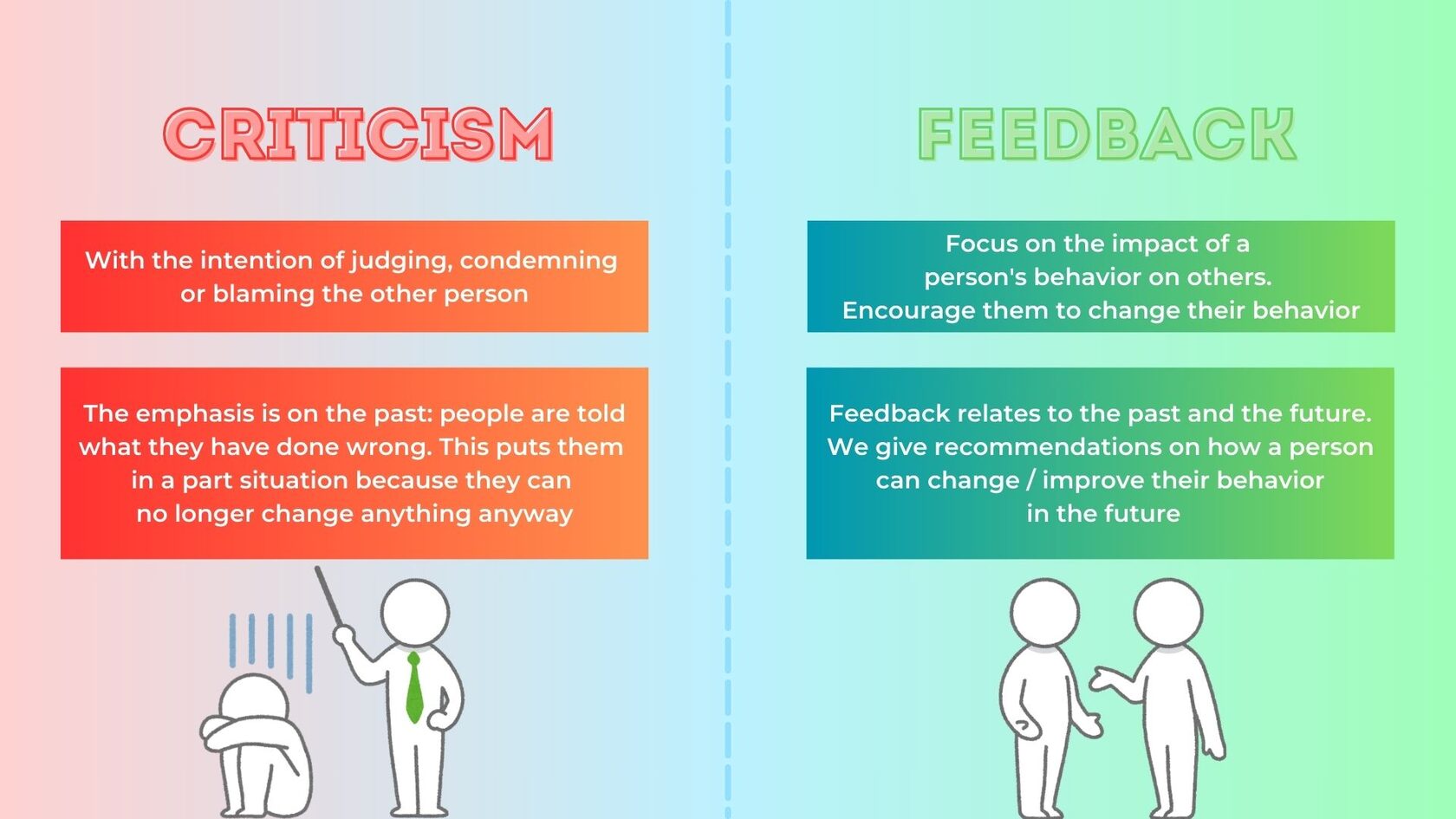Feedback is a central part of human life as social beings. In the business context, many processes rely on communication, thus, making its constructiveness and effectiveness directly impact the success of any company – at the very least, influencing the workplace atmosphere and employee engagement.
Feedback helps individuals understand how their actions and behavior are perceived and evaluated by others, which can, ultimately, improve the quality of their communication.
In this article, we will discuss the difference between feedback and criticism, the benefits of feedback, as well as how to give and request it effectively.

The Difference Between Feedback and Criticism
Feedback focuses on actions or behaviors, while criticism rather targets the person. Feedback should be constructive and help individuals improve, whereas criticism often causes negativity and harms relationships. Feedback also helps individuals identify and address “blind spots” in their behavior, which leads to more self-awareness and conscious personal growth.
Giving feedback in a constructive way requires that you take the adult position in communication. In this context, I recommend the article: Communication at Eye Level: How to Engage in an “Adult” Dialogue.
Feedback helps to uncover so-called “blind spots” in people, which usually leads to better self-understanding and can stimulate conscious personal growth. You can read more about these aspects in the article: Blind Spots: How to Get to Know Yourself Better?

Providing feedback requires a balance of tact and honesty. It’s crucial to avoid excessive underlining of negative aspects, as these can strain relationships. Instead, focus on specific actions or behaviors and provide concrete examples.
For example, telling a colleague, spouse, or friend, “You’re always so pessimistic”, might seem like a casual remark to you. However, the recipient of such a remark may perceive it as a strong judgment of their overall personality. The key question here is: Is this person really ALWAYS pessimistic, in every situation?
Instead, try saying:
“I’ve noticed that lately, you’ve been focusing on the negative aspects of our project/relationship. Could you explain your perspective in more detail?”
Once they respond, follow up with:
“Do you also see any positive aspects?”
Requesting Feedback
Feedback can be requested by asking specific questions or inviting someone to share their thoughts and observations.
Example of How to Request Feedback:
What NOT to do:
“Now that we’ve finished the project, tell me everything I did wrong!”
What TO do:
“We’ve completed the project and gained some experience in working together. I would like to know what you think I did well in our collaboration? Also, what could I improve on? Finally, was there anything about my behavior that made our collaboration difficult for you?”
Examples of Giving Feedback
What NOT to do:
“Let’s skip the positives and jump straight to the negatives that need fixing."
Why ignore the positives? Such an approach focuses solely on the negatives and turns feedback into criticism.
"You’re always late to work! How much longer will this go on?”
This statement narrows the perception of the particular employee to a single issue. Perhaps this employee stays late to ensure their tasks are completed.
Avoid confusing feedback with criticism or focusing on one aspect of a person while overlooking other equally important qualities.
What TO do:
“You did an excellent job completing the project and gave a strong presentation to the client, which helped secure the contract. During the project, I also noticed that you worked hard to find common ground when opinions diverged. At the same time, in meetings you seemed to hesitate to share your thoughts, even though you had them. I encourage you to express your ideas more often and confidently in future projects.”
“I noticed that you’ve been late to work a few times this past month – for example, to last week’s planning meeting and a team discussion. It gives me the impression that you might be less interested in work lately. I’d like to understand what’s going on and see if there’s anything I can do to help.”
Key Takeaways
These examples show that feedback can be used in two ways: to clarify situations (without assumptions) and to highlight both positive and negative aspects of behavior (in an appropriate manner).
It’s important to remain open and receptive to feedback, even if it includes less pleasant aspects. When requesting feedback, it’s recommended to approach people you trust, who understand your work or behavior, and who are willing to share their honest opinions. By leveraging feedback, we continue to grow as human beings and improve in all areas of our lives.
You can quickly learn the skill of giving balanced feedback in a constructive manner in a short-term training course. For more information, you can read the article: What Is Short-Term Training, and What Does It Offer?
In my practical work, I have repeatedly observed that many people find it difficult to ask for or give feedback in a way that is natural and appropriate to the situation. For this reason, I offer a special short-term training course in which you can learn the skill of giving feedback in a constructive way. To find out more, you can visit the “Services” section.